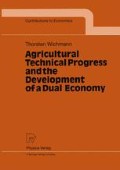Abstract
The previous chapters have focused on the production of agricultural goods and have analyzed those in exogenous as well as in endogenous growth frameworks. In this chapter we focus on the consumption side, especially on the influence food demand and consumption can have on the development process. The produce of the agricultural sector is crucially different from most industrial output. Food is necessary to stay alive, and under- or malnutrition can considerably impair a human’s ability to work. While this may sound trivial and negligible from the point of view of an industrialized economy, such a relation can have important consequences for the development of an economy.
Access this chapter
Tax calculation will be finalised at checkout
Purchases are for personal use only
Preview
Unable to display preview. Download preview PDF.
References
Recall that all homothetic utility functions imply an income elasticity of food demand which is unity (cf. Varian,1984, 118ff.).
The function is named after R. Stone (1954) and R.C. Geary (1949) who have first used it.
Atkeson and Ogaki (1990) have also criticized this behavior as being contradicted by the data. They propose a modification of Houthakker’s (1960) utility function as an alternative. Since the non-homotheticity in the latter is difficult to interpret, however, the Stone-Geary function is used here.
Dasgupta’s main points are summarized in Srinivasan (1994b).
For a short revieew of this development see Bardhan (1993).
Author information
Authors and Affiliations
Rights and permissions
Copyright information
© 1997 Physica-Verlag Heidelberg
About this chapter
Cite this chapter
Wichmann, T. (1997). Food Consumption and Economic Development. In: Agricultural Technical Progress and the Development of a Dual Economy. Contributions to Economics. Physica-Verlag HD. https://doi.org/10.1007/978-3-642-46994-7_6
Download citation
DOI: https://doi.org/10.1007/978-3-642-46994-7_6
Publisher Name: Physica-Verlag HD
Print ISBN: 978-3-7908-0960-2
Online ISBN: 978-3-642-46994-7
eBook Packages: Springer Book Archive

